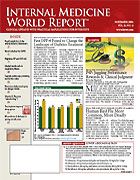Publication
Article
Clinical Trials Update: HF Therapies that Reduce Mortality
Author(s):
Barcelona—Results of several important clinical trials of heart failure (HF) therapy were presented at the 15th World Congress of Cardiology.
Cardiac Resynchronization Reduces All-Cause Mortality
New analysis of the Cardiac Resynchronization in Heart Failure (CARE-HF) study showed that cardiac resynchronization therapy (CRT) in patients with HF reduced sudden cardiac death during extended follow-up and that CRT was as effective in reducing all-cause mortality in patients with diabetes as in those without diabetes.
In CARE-HF, 813 patients with HF caused by left ventricular systolic dysfunction and cardiac dyssynchrony were randomized to pharmacologic therapy alone or to pharmacologic therapy with the addition of CRT.
A previous analysis of CARE-HF showed that CRT reduced mortality by 36% over a mean follow-up of 29.4 months compared with drug therapy alone but that it did not reduce the incidence of sudden cardiac death.
In the most recent analysis, with follow-up extended to a mean of 36.4 months, the incidence of sudden cardiac death was reduced by 53% and overall mortality by 40% in the CRT recipients.
When the data were analyzed in the 207 patients with diabetes, CRT was associated with a reduction in all predefined end points (eg, death and unplanned hospitalization for a cardiovascular event or for worsening HF) and improvements in New York Heart Association (NYHA) functional class and quality of life.
Immune Modulation Beneficial in Some Patients
Immune modulation therapy, in which a patient’s blood is treated ex vivo with controlled oxidative stress and then returned via intramuscular administration, reduces mortality and cardiovascular hospitalizations in a subset of patients with NYHA class II HF.
The ACCLAIM (Advanced Chronic HF Clinical Assessment of Immune Modulation Therapy) trial included more than 2400 patients with NYHA class II to IV HF who were randomly allocated to immune modulation therapy or to placebo. Immunotherapy has been shown experimentally to downregulate the expression of proinflammatory cytokines and upregulate the expression of antiinflammatory cytokines.
P
In the entire study population, immunotherapy did not meet the primary end point of reducing the composite of mortality or cardiovascular hospitalization (8% reduction; = .22).
P
However, in a prespecified subgroup analysis of 689 patients with NYHA class II HF, immune modulation therapy was associated with a 39% reduction in the primary end point( = .003).
There was no increase in infection or other adverse events in the active treatment group relative to placebo.
The findings provide a “strong basis for moving forward with a confirmatory study in this patient population,” said lead investigator Guillermo Torre-Amione, MD, of the Methodist Hospital, Houston.
Initiate Therapy with a Beta-Blocker, Add ACE Inhibitor Later
Starting HF therapy with the beta-blocker bisoprolol (Zebeta) and later adding an angiotensin-converting-enzyme (ACE) inhibitor can reduce the risk of sudden death at 1 year compared with the reverse strategy of starting with an ACE inhibitor and then adding a beta-blocker.
P
Previously, the Third Cardiac Insufficiency Bisoprolol Study (CIBIS 3) demonstrated that the order of drug initiation in patients with HF had no effect on risk of mortality or hospitalization. The new data presented at the meeting, however, showed that the strategy of starting with bisoprolol reduced the risk of sudden death at 1 year by 46% ( = .049), said lead investigator Ronnie Willenheimer, MD, of the Lund University in Malmö, Sweden.
In CIBIS 3, 1010 patients ≥65 years with NYHA class II or III HF and an ejection fraction of ≤35% were randomized to 1 of 2 treatment strategies: (1) bisoprolol, 1.25 mg/day titrated to 10 mg/day over 10 weeks, with the addition of enalapril (Vasotec), 2.5 mg/day titrated to 10 mg/day over 4 weeks, or (2) the reverse sequence. In each regimen, the second drug was added at 6 months. The beta-blocker—first strategy met the criteria for the noninferiority end point of all-cause mortality or hospitalization over the mean follow-up of 1.2 years.
Sudden cardiac death was not a prespecified primary or secondary end point of the trial, reminded Luigi Tavazzi, MD, of the Fondazione IRCCS Policlinico San Matteo in Pavia, Italy. He said that the P value (.049) was of borderline significance, indicating the finding may have been due to chance.






